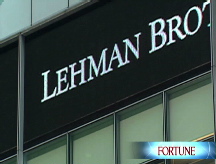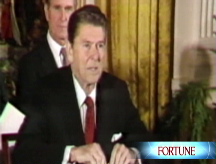How Lehman's fall created a global panic
A leading economist argues that the U.S. government's poor planning turned the investment bank's crisis into a catastrophe.
(Fortune) -- The world changed forever on Sept. 15, 2008, the Monday Meltdown, a day that will live in the annals of finance alongside Black Tuesday, Oct. 29, 1929. We are still odds-on to avoid a depression like the one that followed Oct. 29, but the Monday Meltdown made one more likely, and has claimed trillions of dollars of wealth worldwide and triggered a global recession. Understanding the financial shock that occurred that day is vital to finding a way out of our current mess.
The Monday Meltdown turned a boom-and-bust cycle centered mainly in the U.S. and U.K. into a global financial panic. The global system was highly vulnerable at that moment, so the meltdown did not come out of the blue. But neither was it inevitable. It reflected a series of accidents as well as lack of preparation by U.S. policy makers during the fast-moving financial crisis already underway by Sept. 15.
The background to the Monday Meltdown is now well understood. The roots lay in the combination of financial deregulation of the 1990s and the mistakes of the Federal Reserve under Alan Greenspan. Easy credit conditions, stoked by the Fed's low-interest rate policies after the dot.com meltdown and 9/11, led to a bulge of subprime mortgage lending and other kinds of consumer financing. Deregulation abetted the massive over-extension of credit by enabling Wall Street to expand trillions of dollars of lending and tens of trillions of dollars of derivatives trading on a base of households with shaky creditworthiness. The seeds of trouble were sown.
In a normal financial crisis, over-lending is followed by a retrenchment of credit, a spate of defaults on outstanding loans, the failures of some financial intermediaries, and a recession. The Greenspan housing bubble was set for that course by early 2007. The over-lending had started to dry up in mid 2006. Defaults on sub-prime and adjustable-rate mortgages began to rise as the Fed raised interest rates. A glut of unsold houses soon developed, leading to the peak and then initial decline of soaring housing prices by mid-to-late 2006. The boom was turning into a bust.
By 2007 a U.S. recession was inevitable, and it indeed began in December 2007, according to the National Bureau of Economic Research. Wall Street's "shadow banking system" went into a steep reversal. The falling dominoes included the failure of Bear Stearns mortgage-related investment funds (June 2007), the run on the U.K.'s Northern Rock Bank (September), the collapse of Countrywide Financial (January 2008), the Fed-backed sale of Bear Stearns to J.P. Morgan Chase (JPM, Fortune 500) (March), the collapse of IndyMac Bancorp (July), the Federal takeover of Freddie Mac (FRE, Fortune 500) and Fannie Mae (FNM, Fortune 500) (September), and bank capital losses mounting to the hundreds of billions of dollars.
Yet financial markets continued to function--until the Monday Meltdown. The simultaneous failures of Lehman Brothers (LEHMQ) and AIG (AIG, Fortune 500) (along with Merrill Lynch's capitulation) during the weekend of Sept. 13-14 were too much for the markets to swallow. Lehman filed for Chapter 11 bankruptcy on Sept. 15 after the failure to find a buyer over the weekend. Lehman's default triggered a cascade of failures, starting with a money-market fund (Reserve Primary Fund) that "broke the buck" on Sept. 17 as a result of its losses on Lehman paper.
Panic ensued. Panic in this context means something specific: a self-fulfilling financial failure, in which depositors or short-term creditors run from a borrower (typically a financial intermediary or a sovereign borrower) out of fear of an impending default, and in which the run itself then creates the default. The panic turns out to be "rational" even though it was not inevitable. Like a stampede to the exit of a stadium in which dozens or hundreds are trampled to death, a panic leads to a collapse of functioning institutions that could have have survived without the sudden rush to the exits.
Leadership that is deftly applied can avoid a panic, or even reverse one already underway. Those caught up in the panic need help to understand FDR's maxim: "the only thing we have to fear is fear itself." I believe no credible leadership was available on Sept. 15, and indeed none will be firmly in place until Jan. 20, 2009. The Treasury's abrupt and desperate call for $700 billion in bailout funding four days after the Lehman collapse probably exacerbated the sense of panic, even though the funding request was correct. It just came too late and without a suitable plan.
The panic has kept on roiling since then, including the collapse of more institutions, like Washington Mutual the following week; the collapse of inter-bank lending; the withdrawal of investors from equities, banks, commercial paper, hedge funds, and money-markets in favor of government securities; the effective shutdown of corporate and municipal bond markets; and the abrupt withdrawal of credits to emerging markets stretching from Argentina to Hungary and South Korea; and the collapse of consumer spending.
There are three fronts in the battle to stabilize the patient:
The first is to prevent the panic from causing a systemic collapse of liquidity and sudden insolvency of major financial institutions. Central banks around the world have become the lender of last resort to a widening range of financial institutions and types of credit flows.
The second is to try to foster a restoration of bank lending (and financial intermediation more generally) by injecting public funds into the banking system, so that inadequate bank capital does not become the barrier to revived lending.
The third is to offset the steep decline in consumer and investment spending through a massive fiscal expansion.
The first of these goals is so far being achieved. The central bank credit lines have prevented the banks from simply closing their doors. The second and third goals -- revival of bank lending and a fiscal stimulus to offset the collapse of private spending -- are yet to be achieved.
Only the work of historians will tell us whether the Fed, White House, and Treasury might have saved the day through a softer landing for Lehman Brothers. The answer would seem to be yes--if the authorities had used the preceding months to put an emergency-response plan in place.
Starting next month, President Obama must work to assuage panic, give a sense of direction, cooperate effectively with the rest of the world, and ensure the liquidity and fiscal stimulus to get the global economy out of the Critical Care Unit and onto a path of recovery.
Jeffrey D. Sachs is director of the Earth Institute at Columbia University. ![]()
-
 The retail giant tops the Fortune 500 for the second year in a row. Who else made the list? More
The retail giant tops the Fortune 500 for the second year in a row. Who else made the list? More -
 This group of companies is all about social networking to connect with their customers. More
This group of companies is all about social networking to connect with their customers. More -
 The fight over the cholesterol medication is keeping a generic version from hitting the market. More
The fight over the cholesterol medication is keeping a generic version from hitting the market. More -
 Bin Laden may be dead, but the terrorist group he led doesn't need his money. More
Bin Laden may be dead, but the terrorist group he led doesn't need his money. More -
 U.S. real estate might be a mess, but in other parts of the world, home prices are jumping. More
U.S. real estate might be a mess, but in other parts of the world, home prices are jumping. More -
 Libya's output is a fraction of global production, but it's crucial to the nation's economy. More
Libya's output is a fraction of global production, but it's crucial to the nation's economy. More -
 Once rates start to rise, things could get ugly fast for our neighbors to the north. More
Once rates start to rise, things could get ugly fast for our neighbors to the north. More












